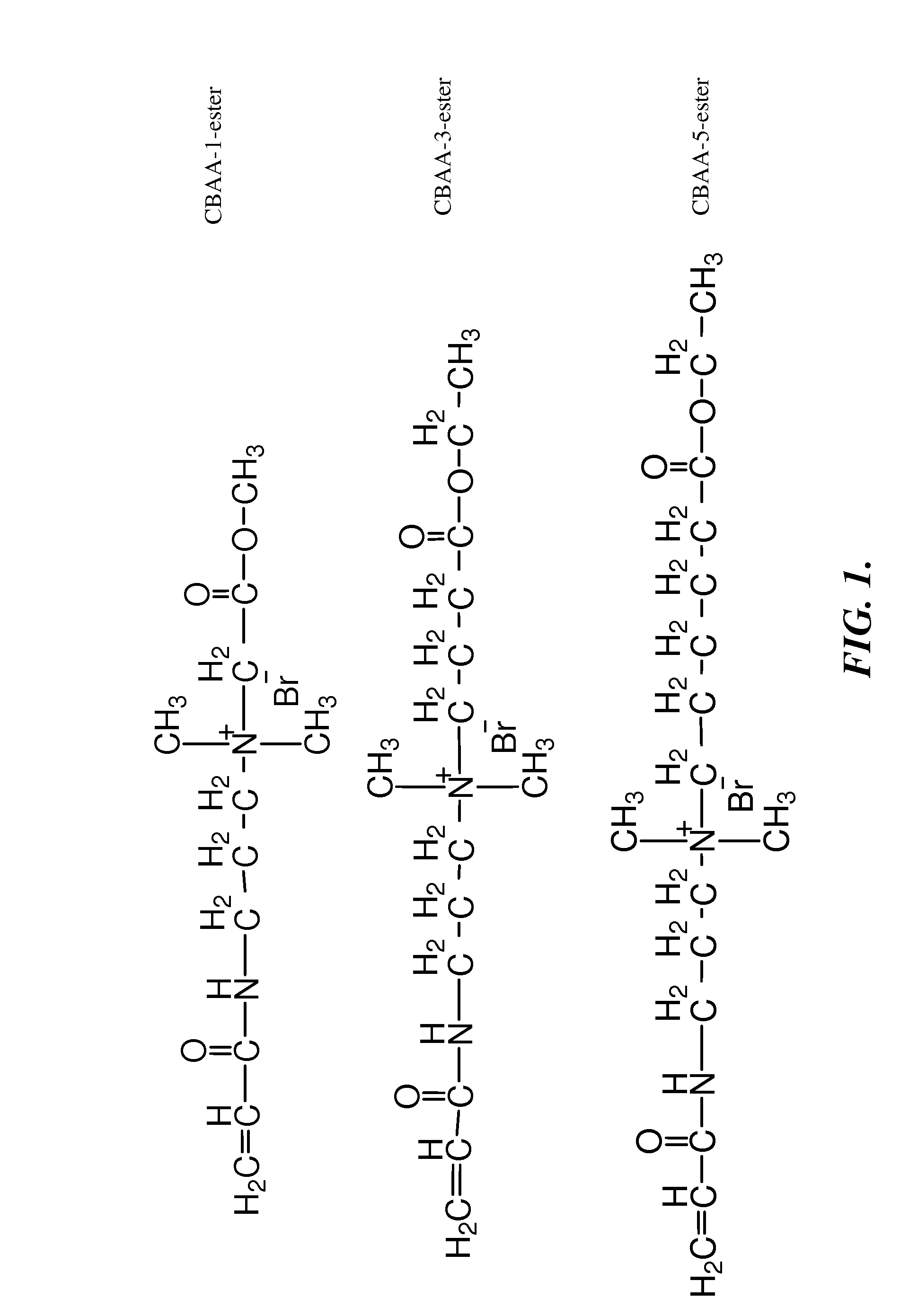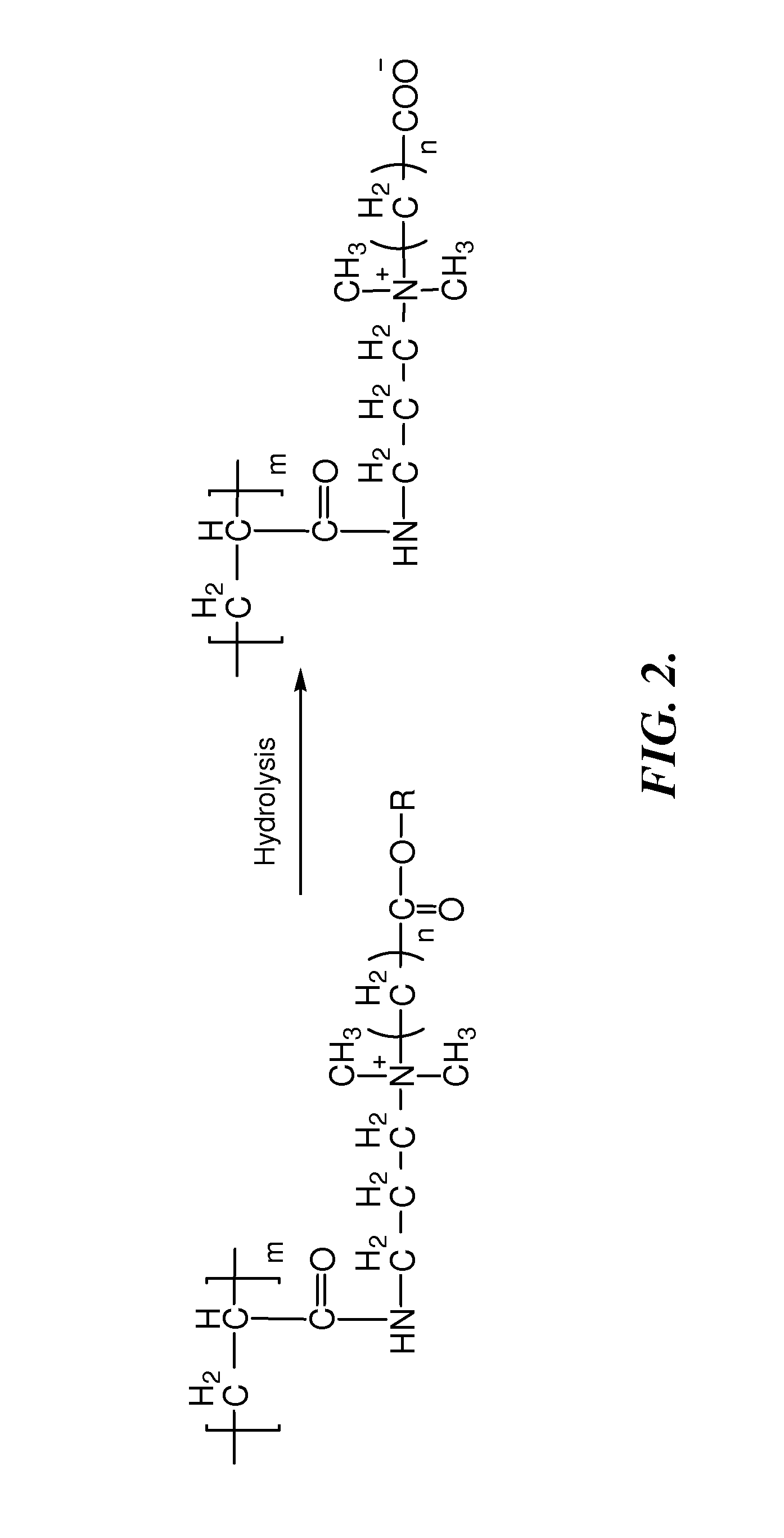Marine coatings
- Summary
- Abstract
- Description
- Claims
- Application Information
AI Technical Summary
Benefits of technology
Problems solved by technology
Method used
Image
Examples
example 1
The Synthesis and Characterization of Representative Cationic Polymers
[0239]Materials. N-(3-dimethylaminopropyl)acrylamide (>98%) was purchased from TCI America, Portland, Oreg. Methyl bromoacetate (97%), ethyl 4-bromobutyrate (>97.0%), ethyl 6-bromohexanoate (99%), copper (I) bromide (99.999%), bromoisobutyryl bromide (BIBB 98%), 11-mercapto-1-undecanol (97%), and 2,2′-bipyridine (BPY 99%), and 2,2′-azobis(2-methylpropionitrile) (AIBN 98%) were purchased from Sigma-Aldrich. Fibrinogen (fraction I from bovine plasma) and phosphate buffer saline (PBS, pH7.4, 0.15 M, 138 mM NaCl, 2.7 mM KCl) were purchased from Sigma Chemical Co. Ethanol (absolute 200 proof) was purchased from AAPER Alcohol and Chemical Co. Water used in experiments was purified using a Millipore water purification system with a minimum resistivity of 18.0 MΩcm.
[0240]ω-Mercaptoundecyl bromoisobutyrate (1) was synthesized through reaction of BIBB and (2) using a method described in Ilker, M. F.; Nuesslein, K.; Tew, G. ...
example 2
Representative Cationic Polymer Hydrolysis
[0250]The cationic polymers prepared as described in Example 1 were dissolved in NaOH solutions with different concentration (10 mM, 100 mM, and 1 M) in a concentration of 50 mg / mL After an appropriate time interval, the polymer solutions were neutralized with dilute HCl solution and the water was removed by vacuum 1H NMR spectroscopy (D2O) was performed to measure the degradation rate by determining the amount of intact ester groups and comparing with other non-hydrolyzable pendant groups as inner standards. The results are illustrated in FIG. 3.
example 3
Representative Cationic Polymer Protein Adsorption and Release
[0251]The cationic polymers prepared as described in Example 1 were evaluated for protein adsorption by surface plasmon resonance (SPR).
[0252]Protein adsorption was measured with a custom-built SPR sensor, which is based on wavelength interrogation. A SPR chip was attached to the base of the prism, and optical contact was established using refractive index matching fluid (Cargille). A dual-channel flow cell with two independent parallel flow channels was used to contain liquid sample during experiments. A peristaltic pump (Ismatec) was utilized to deliver liquid sample to the two channels of the flow cell. Fibrinogen solution of 1.0 mg / mL in PBS (0.15M, pH 7.4) was flowed over the surfaces at a flow rate of 0.05 mL / min A surface-sensitive SPR detector was used to monitor protein-surface interactions in real time. Wavelength shift was used to measure the change in surface concentration (mass per unit area). The results are...
PUM
| Property | Measurement | Unit |
|---|---|---|
| Hydrophobicity | aaaaa | aaaaa |
| Antimicrobial properties | aaaaa | aaaaa |
Abstract
Description
Claims
Application Information
 Login to View More
Login to View More - R&D
- Intellectual Property
- Life Sciences
- Materials
- Tech Scout
- Unparalleled Data Quality
- Higher Quality Content
- 60% Fewer Hallucinations
Browse by: Latest US Patents, China's latest patents, Technical Efficacy Thesaurus, Application Domain, Technology Topic, Popular Technical Reports.
© 2025 PatSnap. All rights reserved.Legal|Privacy policy|Modern Slavery Act Transparency Statement|Sitemap|About US| Contact US: help@patsnap.com



